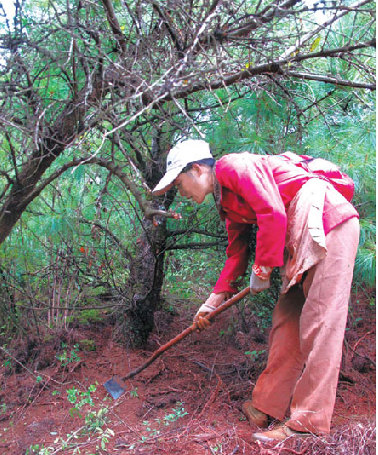Threat to truffles leaves a bad taste
 0 Comment(s)
0 Comment(s) Print
Print E-mail
China Daily, November 3, 2011
E-mail
China Daily, November 3, 2011
 |
|
A villager from Gaoshitou hunts for truffles with an iron hoe. The soil has been dug so many times that the roots of some pine trees, which are part of the reproduction process, are exposed. |
Truffles are called the "king of fungi" for good reason. Aficionados pay a king's ransom for these underground mushrooms that resemble stones in appearance.
Specialty markets in Europe open in December or January, when the truffles are mature. Thousands of fans and sellers gather to trade, with prices averaging $2,000 to $3,000 a kilogram.
These gourmets may be at risk of indigestion if they knew that on the other side of the world, in China, truffles sell for less than $100 a kilo and markets open five months earlier.
Chinese farmers are satisfied with the relatively pitiful sums, a fortune when set against their usually low income. But growing demand brings its own pitfalls. Few farmers realize that overeager truffle hunting is pushing the fungi to the brink of extinction.
The truffles that Pang sells are black balls with a rough surface, no bigger than a ping-pong ball. The scent is slight but distinctive. "I think it is much like the smell of brown sugar," she said.
Pang, 42, would give only her family name as she worked at one of the biggest mushroom markets in Nanhua county, Chuxiong autonomous prefecture, in northwest Yunnan province.
She has sold truffles since 2006, she said, and the price the past two or three years has averaged 400 to 500 yuan a kg. "The price peaked at 600 yuan per kg last December and we had started to collect truffles from local farmers in July or August," she said.
"The mature ones collected in December and January have a stronger fragrance and sold at higher prices. But the premature ones also sold well, and cheaper."
Statistics from the county's commercial department show that 709 tons of truffles were traded last year, producing revenue of more than 11 billion yuan ($1.72 billion). Nanhua has three major mushroom markets with hundreds of sellers. Everyone sells at least four or five kinds of mushrooms but only one in five sells the underground variety, truffles.
Pang said she sold about 20 kg every day last month, at 300 yuan a kg. "It will be priced higher in December," she said cheerfully. "It is the most profitable mushroom of all."
When told that mature truffles sell in Europe for what amounts to tens of thousands of yuan, she couldn't hide her surprise. But a few minutes later, she seemed indifferent. "We can't control things that far away. After all, earning this much is enough."
Taste tests
"That is the attitude of most local farmers, which has become the biggest problem for us to protect truffles," Liu Peigui said. "If they continue to hunt truffles before the mature season, it will lead to extinction in the next three or five years."
Liu is a researcher at Kunming Institute of Botany, Chinese Academy of Sciences, who has devoted nearly 30 years to studying wild mushrooms. He said China has more than 1,000 edible macro-fungi and 80 percent of them grow in Yunnan province.
"Truffles have the highest economic value among those 800 kinds. People in Western countries deny the quality of truffles in China, but our research found that the similarity of their fragrances is 95 percent." In blind tastings, he said, "Some even say Chinese truffles are better."
They were good enough to spark a boom in mushroom trade with European countries about eight years ago, two years after the truffle trade emerged in Yunnan. Farmers realized the potential, but went after the profits through what Liu calls irrational hunting.
They need each other
Liu described the situation this way:
Eighty percent of mushrooms have a symbiotic relationship with a certain plant. Truffles, for example, usually grow with chestnut, pine or hazel trees. Unlike plants with roots, truffles start from spores, which play the role of their seeds. Spores produce hyphae that will later infect the root of its "partner tree". Hyphae are nourished by the tree and later grow into truffles.
After they have successfully infected the root, hyphae need four or five years to grow into truffles. If mature truffles are collected without hurting the hyphae, new truffles will grow next year.
"It is not a unilateral benefit. Truffles produce enzymes that will break down nutritive material. Then the partner trees will grow better," Liu said.
"Only mature spores are able to produce new generations. Premature gathering will not only bring down the price of truffles but also break the chain of their reproduction."
What is more worrisome is the rough manner in which Yunnan truffles are harvested. The hoes and iron-toothed rakes that local farmers use to dig out truffles - instead of gather them - destroy hyphae under the surface. Without hyphae that connect to trees, truffles can no longer grow.






Go to Forum >>0 Comment(s)